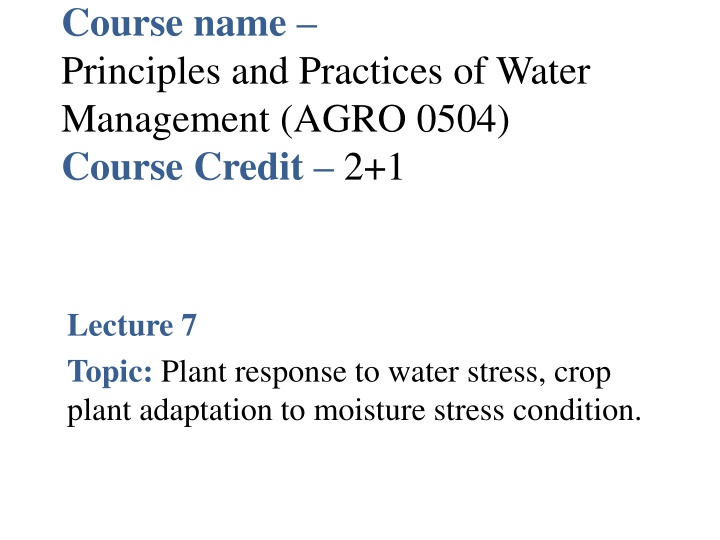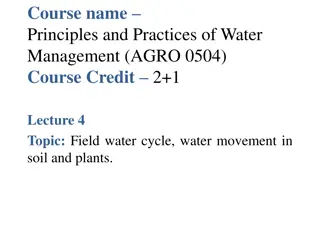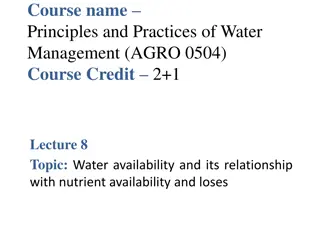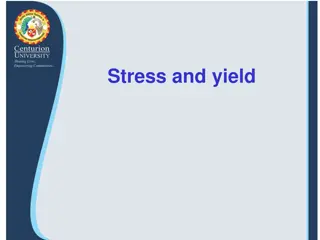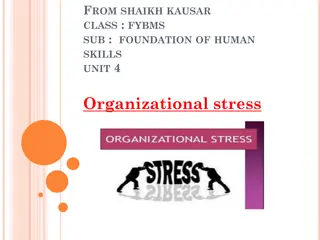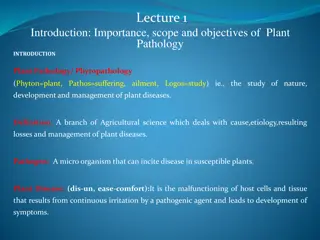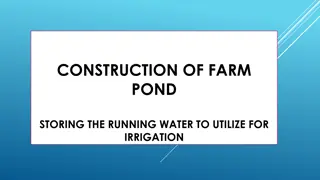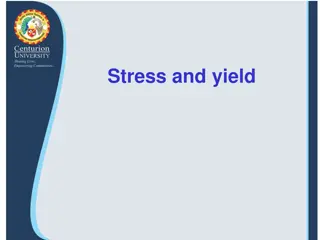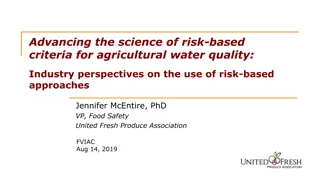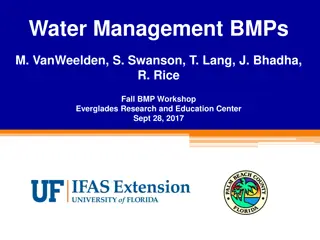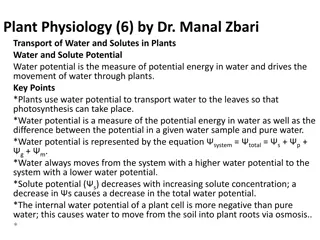Plant Responses to Water Stress in Agricultural Management
Understanding how plants respond to water stress is crucial for effective agricultural management. Stress can affect plant growth and development, leading to various adaptations such as resistance, avoidance, and tolerance. This course explores the physiological mechanisms behind plant stress responses, including drought resistance and injury symptoms like wilting and leaf discoloration. Strategies for managing water stress in crop plants are discussed, highlighting the importance of adaptation, avoidance, and tolerance mechanisms.
Download Presentation

Please find below an Image/Link to download the presentation.
The content on the website is provided AS IS for your information and personal use only. It may not be sold, licensed, or shared on other websites without obtaining consent from the author.If you encounter any issues during the download, it is possible that the publisher has removed the file from their server.
You are allowed to download the files provided on this website for personal or commercial use, subject to the condition that they are used lawfully. All files are the property of their respective owners.
The content on the website is provided AS IS for your information and personal use only. It may not be sold, licensed, or shared on other websites without obtaining consent from the author.
E N D
Presentation Transcript
Course name Principles and Practices of Water Management (AGRO 0504) Course Credit 2+1 Lecture 7 Topic: Plant response to water stress, crop plant adaptation to moisture stress condition.
1. Physiology Stress Stress: Stress in physics is any force applied to an object. Stress in biology is any change in environmental conditions that might reduce or adversely change a plant s growth or development. Such as freeze, chill, heat, drought, flood, salty, pest and air pollution etc. Resistance: resistance is the ability adaptive or tolerant to stresses.
Resistance includes adaptation, avoidance and tolerance. Adaptation is permanent resistance to stress in morphology and structure , physiology and biochemistry under long-term stress condition. a well-developed aerenchyma in hydrophytes, a pattern for stomata movement in CAM plant.
Avoidance is a manner to avoid facing with stress using neither metabolic process nor energy. Very short lifecycle in desert plants. Dormancy during the cool, hot, and drought conditions. Tolerance is a resistant reaction to reduce or repair injury with morphology physiology, biochemistry or molecular biology, when plant counters with stresses. , structure, Hardening is a gradual adaptation to stress when the plant is located in the stress condition.
1. Water stress in plant Resistance of plant to drought Drought injure: Soil drought, no rain for long time and no- available water in the soil. Air drought, RH<20% in atmosphere transpiration>>water absorption. If longer, soil drought occurs. Drought injury is actually in physiology.
Symptoms in plant facing to droughtstun, red color in base small cell and leaf area leaf yellowish and abscission. Young leaves or/and reproductive organs wilt to death. 2 Mechanism of drought injure Membrane damage. Like senescence, biomembrane changes in states, such as hexagonal phase and become leaked.
Metabolic disorder Redistribution of water among organs drought Re-watering
(2)Photosynthesis decreases, while respiration rises after lowering Starvation to death a.assimilate SC Photorespiration electron transfer activity and PSP .In sunflower, - 1.1MPa ET and PSP decrease obviously -1.7 MPa, PSP is 0 b. inhibition by photoassimilate feedback. 3 Decrease in nuclear acids and proteins Protease activity free aa RNAase activity RNA hydrolysis ,DNA content falls down.
4 Pro from protein hydrolysis; synthesis oxidation Pro function detoxification of NH3; 5 Changes in plant hormones inhibitors esp. ABA . 6 Poisonous agents accumulation amines . Cytoplasm is broken down Pro accumulation bound water . promoters NH3 and
Mechanical injure 1.1.2Mechanisms of resistance to drought and the methods to increase the resistance 1.1.2.1. Mechanisms of resistance 1 Morphology increase in water absorption and transportation , declination of transpiration. a. Developed root system and higher ratio of root to shoot b. Thick leaf , smaller leaf area and thick cuticle c. Developed bundle and veins more stomata smaller and
Physiology and biochemistry a. Stomatal regulation ABA accumulation stomatal closure b. Increase in capacity of resistance to dehydration of cytoplasm Rapid accumulation of Pro, glycinebetaine Lea protein, dehydrin, osmotins and ion etc.
Methods to increase the resistance 1 drought Selection of cultivars with high resistance to high yield and quality. 2 technology to control seed water absorption and re-drying slowly drought hardening Seed priming special
3 of more P K to plants. Suitable fertilizer application Application 4 0.25% CaCl2 or 0.05%ZnSO4 solution. Application of plant substance: ABA, CCC etc Chemical regents application Soaking in
Resistance of plant to flood Flood injury: moisture injury and flooding injury. Moisture injury is caused by soil space filled with water and without air. Flooding injury: whole plant or part of shoot is submerged to water while flooding
Injures of flood to plant Flood is actual deficiency in O2Anything increases in soluble O2, the injury will decrease. And anything decreases in soluble O2, the injury will increase. Such as slowly streaming water less damage than static water.
(1) Injury in morphology and anatomy by O2 deficiency growth leaf yellowish (nutrition deficiency root darkness low epinasty, air root(IAA), stem hollow (tissue degradation . (2) Injury in metabolism by O2 deficiency: photosynthesis stomatal block, inhibition of CO2 entrance . Anaerobic respiration toxicants: alcohol acetaldehyde NH3 lactate , H2S
(3) Nutrition disorder Absorption soil N,P,K,Ca loss but H2S, Fe, Mn microelements poison. (4) Changes in plant hormones IAA and CTK . ACC synthesis in root and release of Eth in shoot. (5) Mechanical damage and infection by harmful organism
Mechanism of resistance to flood Resistance is different in plants:hydrophytes>land plants rice>rape>barley; O.sativa>O.japonica and in growth stages : seedling >other stages, (1) Tolerance in tissues Well-developed aerenchyma (2) Tolerance in metabolism develops in anaerobic dehydrogenase tolerance to ethanol ; PPP instead of EMP NR Glutamate dehydrogenase Ex- jalsakti , jal priya mitochondria well conditions, succinic acid
Temperature stress Temperature stress: Low or high temperature, called frost injury or heat injury, respectively. 2.1 Frost ( freezing )injury The injury is caused by low temperature below freezing point (< 0 ),companied with frost.
Mechanism of freezing (frost )injury Freezing:(intercellular and intracellular freezing) (1) Intercellular freezing Freezing ice Intercellular freezing occurs when temperature falls gradually.
Intracellular Freezing Intracellular freezingoften occurs when temperature falls suddenly. Ice results in the direct injury in cytoplasm, biomembrane and organelle, and damages to cell compartmentation and metabolic disorder. Much more serious damage is caused by Intracellular Freezingthan by Intercellular Freezing. Damage of protein Sulfhydryl group hypothesis disulfide bridge hypothesis
Damage of biomembrane Electric conductivity cell material leakage photochemical activity and ATP production , while photoinhibition CF1 and PC depart from membrane. Change in state of lipid and protein denuturation
Chilling injury Chilling injury in tropical or subtropical plants is caused by temperature above 0 (freezing point ).. Maize, cotton rice seedling- 10 Rice pollen-mother cell division 23 for O. sativa and 20 for O. japonica. Banana tree 13 Oak tree 5
Metabolism disorder 1 Uptake function of roots declines and water balance disorders Transpiration>water absorption. The plant loss water and leaf curl 2 Photosynthetic rate lowers Photosynthesis< respiration, starvation to death. Rubisco losses activity under low temperature PSP uncouples and free radicals breaks suddenly.
3Aerobic respiration decreases and anaerobic respiration increases Cytaa3 activity , respiratory electron transport and phosphorylation activities . Ethanol poison. 4 Organic substance degrades protease protein RNA,ATP .
Physiological reaction of plant to low temperature (1) Water content, metabolism, growth decrease . Total water content bound water free water and ratio (free water/bound water) (2) Protective substances increase NADPH reduces ATP and sugar , bound water .
(3) Unsaturated fatty acid increase in membrane Unsaturated fatty acid and saturated one . (4) ABA GA , dormancy appears. (5) Proteins-resistant to freezing accumulations. Freezing resistant protein Ice-Box The genes expression induced by freeze freeze- resistant protein.
Methods to increase the resistance to low temperature (1) The resistant cultivars. (2) Low temperature hardening. (3) Chemical control. ABA ,CCC). (4) Others. PK application, keep warm with artificial things.
High temperature stress and heat resistance of plants Cold-favored plants: some alga bacteria and fungi meets heat injury at 15 20 . Temperature-mediate plant: most of crops 35 . Temperature-favored plants: some alga bacteria 65 100 many CAM plants>50 . Heat injury is a damage to the temperature- mediate plant by high temperature above 35 .
Reasons for heat injure Indirect damage 1 Starvation 2 Poisoning Ethanol or acetaldehyde, free radicals 3 deficiency of biotins Biotins Vitamins 4 damage of nuclear acids and proteins. Temperature compensation point: Pn is equal to zero at high temperature Respiration is much larger than photosynthesis.
50 Total rate photosynthetic 40 30 Respiration rate Pn 20 10 0 0 20 40 60 -10 -20 Temperature ( ) Respiration is larger than photosynthesis under low temperature
Direct damage 1 Configuration damage The degree in denaturation is positively related to water content in plant tissue. Dry seed is able to resist to 70 80 Protein denaturation
2 Lipid liquefaction liquefaction High temperature liquid-crystalline state Low temperature Solid-gel state
Mechanism of heat resistance (1) High stability of protein under heat stress (2) Lower water content (3) High contents of saturated fatty acid. (4) High contents of organic acid CAM extremely heat-resistance a great number of organic acid. Lessen or protect them from NH3 poison.
(5)Form of heat shock proteins (HSPs or hsps) Heat shock proteins are a newly synthesizing set of proteins that organisms ranging from bacteria to humans respond to high temperature. Functions: protect or repair proteins, nuclear acids and biomembrane from heat injury.
Salt stress and resistance to salt Over 1% of salt content in reclaimed tideland 0.2~0.25% of salt content in the northern basic soil . 1/5-1/3 of total cultivated land . Mechanism of salt injure 1. Physiological drought 2. Single salt toxicity .Na+ and Cl- SO4 . 3. Metabolic damage degradation ,Pro NH4+ poison . Ch1 and Rubisco protein
Mechanism of resistance to salt Methods resistant to salt
Resistance to plant diseases 4.1 Types of plant response to diseases. Three types: resistance, sensitivity and tolerance
Physiological damage of plant diseases to plants 1.cell membrane permeability increases. 2. Metabolism disorders. Water metabolism(absorb, loss and transport). Photosynthesis Respiration Assimilate transport.
Resistance of plant to plant diseases 1.Formation of protective structure. 2.hypersensitive response. Synthesis of phytoalexins and fungitoxic proteins and pathogenesis related proteins (PRs) 3.immuno-induction.
The role of plant in environmental protection 1.O2 and CO2 equilibrium; 2.Prevent water and soil loss. 3. Clean soil, water or other environmental conditions or detoxification. 4.Detect environmental conditions
General response to stresses 1.Damage in biomembrane system 2. Disorder in metabolism 3. Functional proteins denuturation and stress protein synthesis 4. Osmotic substance synthesis 5. Change in plant hormones
1.does chilling injury damage the plants in physiology and in which season does chilling injury occur frequently. 2. Which of stresses result in water potential declination and how to do them?
